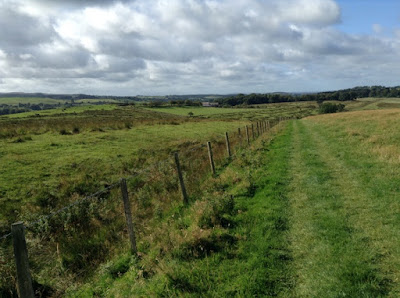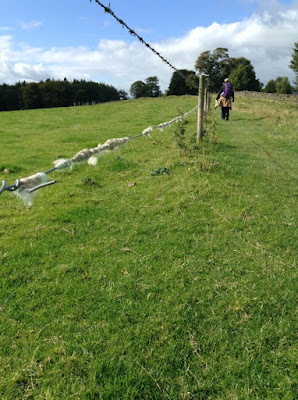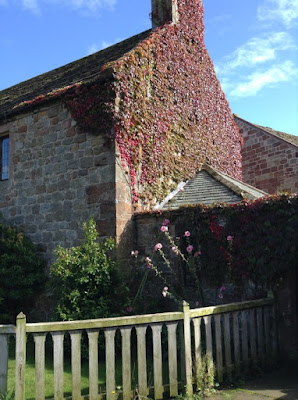After a deluge the previous evening, we awoke to sun and beautiful blue skys for our walk today! Only 7 miles (11 km), so plenty of time to poke about and linger a bit if we found somewhere particularly scenic or interesting.
We had arranged for a packed lunch today, as there weren't really any places to stop en route. After a hearty breakfast (with slightly over-salted oatmeal - my only real complaint with this superb B&B), we set off.
The lovely warm stone of Brook Side Villa B&B, our home for two nights.
We crossed into a new county today (technically on our arrival the day before, but I didn't think to take photos then) - Welcome to Cumbria, more understated than its neighbour apparently - certainly with a softer "accent".
The remains of another milecastle, in Gilsland.
There are those in Gilsland who want to re-open the train station, I imagine to bring in some needed tourism from people other than Wall walkers. It's a pretty place, and definitely has some history. There's currently a petition for this.
The Roman wall was fairly easy to distinguish from the other field walls - it's built of square blocks and is much wider and flatter. It also uses mortar to hold the bricks together, whereas the fieldstone walls don't. You can see the footings here and portions that remain. It's been heavily 'recycled' into various local buildings (churches, manor houses, barns, etc). It was originally about 5m high (approx 16.5')!
Rights of way through farmyards often brought us up close and personal with some of the residents. These chickens were getting some sunshine and had absolutely no fear of us. Isn't she lovely?
You can see here the remains of the wall after years of pilfering. It's good that UNESCO stepped in to save it, really. It's a fascinating history and this party of the country - all the way from Newcastle to Bowness - really benefits from the remains of the wall, the forts, various Roman artefacts, etc.
Rebels at heart!
Remember the part where we're not supposed to be ON the wall?
This was the remains of an old bridge that crossed the River Irthing (to the left of the photo, just behind the trees). The river has changed course in the interceding years, so all we're left with is a bit of a confusing jumble of stones. There is a board here with an explanation and drawing of what it looked like and what the remnants are.
We arrived at Birdowald Fort mid-morning and decided to have a look around.
This fellow doesn't look particularly happy with his job!
Perhaps because this one is shouting at him from 5m up?
"You there! Work harder, go faster!" Sound familiar?
A display about what the Romans ate. It was surprisingly diverse and healthy (not that I was expecting bags of crisps and chocolate, but still!).
Avenues and barracks for the Legions stationed at this point.
Back to fields. It was advised and encouraged to please walk side by side, rather than single file to ensure even wear on the land. It wasn't always possible, but I think we did pretty well for the most part.
Beech trees have the most amazing root systems!
More fields...
...through a lovely wood...
...and arriving at an Honesty Box, where we paid £1 each for a can of cold Coke (the £1 goes into the black box on the date marker). The young fellow who set this up is in the photo beside Jane. His name is Matthew and it shows him with his dog (who was in residence at the time).
It was nice to take a few minutes to rest and relax. It also started to rain a bit at this point, so I took the opportunity to get myself sorted for that.
Thanks, Matthew! :)
Looking back - less spectacular than the previous couple of days, but better in terms of easier movement. We made good time today.
The view from our lunch spot.
Pretty cottages everywhere!
Some mysterious trees...
...and some more pretty flowers. These grew mainly by the roadsides in semi-damp areas in particular. They look like orchids, but as that's highly unlikely, does anyone know??
Lanercost Priory - a 12thC priory standing through revolutions (apparently there are musket ball holes in the face and walls!) and 900 years of change.,
And no, it's not your eyes - it IS slightly off-centre.
It was approximately a mile from the path, and definitely somewhere worth visiting. The church was still in use, although the priory behind it was in ruins. There is a B&B on site, a cafe and a self-catering section. I think it would be a fantastic place to spend some time. The area has plenty to see and do.
Autumn colours already! So pretty.
The lady in the gift shop was quite a talker. I bought a book and had decided not to go into the priory behind, but she (somehow) convinced me that it would be free if I bought an English Heritage membership, which I did after much confusion and time. My "free" visit cost me £50.
To be fair, it's an annual membership, and there are hundreds of places around the country I can now visit free of charge. I just have to do it! It would be silly not to visit at least a few of them.
I was hoping that maybe one or two orbs might show up in here, considering the age of the place. Surely there are a few residents still hanging about...
It's a beautiful place, though.
Off we go again, following the fieldstone road!
Idyllic places everywhere.
And there's our destination, the village of Walton. On the hill.
These young ones were curious, but more hungry than anything, waiting for their dinner to arrive.
We got picked up in Walton by the B&B owner, who arrived at the same time we did! It would have been nice to spend a bit of time poking around the village once we'd got there, but there we go.
We learned about the Reavers on the way back. Part of what I find fascinating about England is that so many people stay put in a place. Less so now, I think, with the younger folks off and about for work, etc., but the English put down roots and let them sink into the earth for a solid foundation. There have been families here - much like the New Forest - for hundreds and hundreds of years.
Reaver is defined as this:
reaver
n.
Old English reafere "plundering forager," agent noun from reafian (see reave(v.)). Cf. Old Frisian ravere, Middle Dutch rover, Dutch roover, Old HighGerman roubari, German Räuber.
reave
(redirected from Reavers)
Also found in: Legal, Wikipedia.
v. reaved also reft (rĕft), reav·ing, reaves Archaic
Basically, life in the north was harsh and hard and reavers were those who lived on the borders (Scotland & England) who would rob and plunder homesteads of their stock (sheep, cattle, horses, etc). They raided both ways across the borders.
The Wikipedia page is here.
Some of the reaver families are still there! The B&B owner, Gerry, said that at least 5 of their neighbours had "reaver" names. Amazing.
We had a pub dinner that night, along with the rest of the crowd at the B&B. I don't remember what I had, but I know I polished it off, whatever it was. My appetite certainly didn't diminish while we were walking, that's for sure.













































2 comments:
Hi Annie: I'm glad you put that info about the reavers in your post - I want to explore that history a bit more but had sort of forgotten about it. I forget where I posted it but will add here that I changed an album on mine on facebook to "shared" so that you can contribute or copy/save photos from it. It's the one called from Newcastle to Heddon on the Wall. See if you can get into it and if it works I'll change the rest to "shared" also. Toodles!
Hi Jane! Thanks for letting me know - once I'm back on FB I'll have a look for it (could also try Dropbox if that doesn't work). I wanted to add the Reaver/Reiver part so that I would remember too, as it's an interesting history of that part of England, for sure. xx
Post a Comment